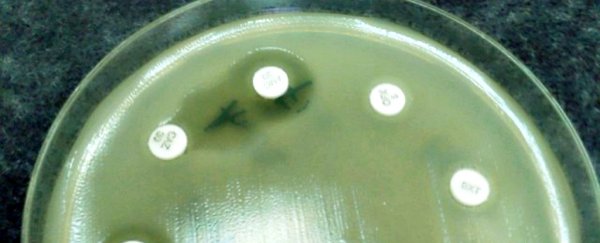Scientists have developed a molecule that reverses antibiotic resistance in multiple strains of bacteria at once, making it one of the most promising advances we've had to date in the fight against superbugs.
The announcement couldn't come at a better time - in the past week, researchers have reported that a US woman was killed by a superbug resistant to every available antibiotic, and that antibiotic resistance is now spreading faster and more stealthily than they'd expected. In the war against superbugs, we're currently losing.
Even public health officials, known for their 'keep calm and carry on' approach to emerging health threats, are quietly freaking out. A report in 2014 predicted that superbugs will kill 300 million people by 2050, and the United Nations has declared the issue a "fundamental threat".
The problem is that bacterial infections we've easily been able to deal with in the past, such as pneumonia, E. coli, and gonorrhoea, are rapidly evolving the ability to survive our antibiotics. Unless we come up with some new drug options soon, we're going to very quickly run out of ways to protect ourselves.
"We've lost the ability to use many of our mainstream antibiotics," said lead researcher Bruce Geller from Oregon State University.
"Everything's resistant to them now. That's left us to try to develop new drugs to stay one step ahead of the bacteria, but the more we look the more we don't find anything new," he added.
"So that's left us with making modifications to existing antibiotics, but as soon as you make a chemical change, the bugs mutate and now they're resistant to the new, chemically modified antibiotic."
One of the ways that bacteria spread antibiotic resistance is through a gene that produces an enzyme known as New Delhi Metallo-beta-lactamase (NDM-1).
NDM-1 is so worrying, because it makes bacteria resistant to a class of penicillins called carbapenems - better known as our 'last resort' drugs. Thanks to NDM-1, that last resort is quickly failing.
"The significance of NDM-1 is that it is destroys carbapenems, so doctors have had to pull out an antibiotic, colistin, that hadn't been used in decades because it's toxic to the kidneys," said Geller.
"That is literally the last antibiotic that can be used on an NDM-1-expressing organism, and we now have bacteria that are completely resistant to all known antibiotics."
To try to fight this, Geller and his colleagues have created a molecule that attacks NDM-1, and reverses antibiotic resistance in many different strains of bacteria - meaning it could give us the chance to use antibiotics again which are currently useless.
The molecule is a type of PPMO, which stands for peptide-conjugated phosphorodiamidate morpholino oligomer, and it disables NDM-1.
Previously, researchers had tried to use naturally-occurring PPMOs against superbugs, but they only worked on one particular strain of bacteria. This new molecule is different.
"We're targeting a resistance mechanism that's shared by a whole bunch of pathogens," said Geller.
"It's the same gene in different types of bacteria, so you only have to have one PPMO that's effective for all of them, which is different than other PPMOs that are genus specific."
The team tested the new PPMO out on three different genera of bacteria in a petri dish - all of which expressed NDM-1 and were resistant to carbapenems.
They used the new molecule alongside a type of carbapenem called meropenem, and showed that it quickly restored the antibiotics' ability to kill the bacteria.
They then used a combination of the new PPMO and meropenem on mice who were infected with antibiotic-resistant E. coli, and showed it could effectively treat the infection and improve survival rates for the mice.
This suggests that, in future, the PPMO could be used alongside existing antibiotics to make bacteria susceptible to them once again.
"A PPMO can restore susceptibility to antibiotics that have already been approved, so we can get a PPMO approved and then go back and use these antibiotics that had become useless," said Geller.
To be clear, showing that this strategy works in the lab and in mice isn't evidence enough that it will work in humans just yet, but the team says it could be ready for clinical trials in the next three years.
Until then, we'll have to wait and see. But it's the first bit of good news we've had about superbugs in a long time, so we'll be watching the progress closely.
The research has been published in the Journal of Antimicrobial Chemotherapy.
